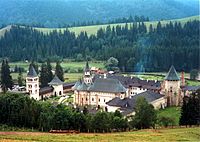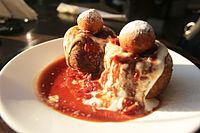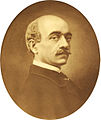Culture of Romania
This article has multiple issues. Please help improve it or discuss these issues on the talk page. (Learn how and when to remove these template messages)
|
| Part of a series on the |
| Culture of Romania |
|---|
 |
|
People |
| Languages |
| Sport |
The culture of Romania is an umbrella term used to encapsulate the ideas, customs and social behaviours of the people of Romania that developed due to the country's distinct geopolitical history and evolution. It is theorized that Romanians and related peoples (Aromanians, Megleno-Romanians, and Istro-Romanians) were formed through the admixture of the descendants of Roman colonists[1] and the indigenous Paleo-Balkanic people who were subsequently Romanized.
Background

Romania's history has been full of rebounds: the culturally productive epochs were those of stability when the people proved quite an impressive resourcefulness in the making up for less propitious periods and were able to rejoin the mainstream of
The modeling role of France, especially in the fields of political ideas, administration, and law, as well as in literature, was paralleled, from the mid-19th century down to World War I, by German culture as well, which also triggered constant relationships with the German world not only at a cultural level but in daily life as well. With the arrival of Soviet communism in the area, Romania quickly adopted many soviet influences, and Russian was also widely taught in the country during Romania's socialist years.
History
Middle Ages

Until the 14th century, small states (Romanian: voievodate) were spread across the territory of Transylvania, Wallachia, and Moldavia. The medieval principalities of Wallachia and Moldavia arose in the mid 1300s, in the areas south and east of the Carpathian Mountains respectively.
Moldavia and Wallachia were both situated on important commercial routes often crossed by Polish, Saxon, Greek, Armenian, Genovese, and Venetian merchants, connecting them well to the evolving culture of medieval Europe. Grigore Ureche's chronicle, Letopisețul Țărîi Moldovei (The Chronicles of the land of Moldavia), covering the period from 1359 to 1594, is a very important source of information about life, events, and personalities in Moldavia. It is among the first non-religious Romanian literary texts; due to its size and the information that it contains, it is arguably the most important Romanian document from the 17th century.
The first printed book, a prayer book in
Dimitrie Cantemir, a Moldavian prince, was an important personality of the medieval period in Moldavia. His interests included philosophy, history, music, linguistics, ethnography, and geography. His most important works containing information about the Romanian regions were Descriptio Moldaviae, published in 1769, and Hronicul vechimii a romano-moldo-valahilor (roughly, Chronicle of the Antiquity of the Romano-Moldavo-Wallachians), the first critical history of Romania. His works were also known in western Europe, as he authored writings in Latin: Descriptio Moldaviae (commissioned by the Academy of Berlin, the member of which he became in 1714) and Incrementa atque decrementa aulae othomanicae, which was printed in English between 1734–1735 (second edition in 1756), in French in 1743 and in German in 1745 ; the latter was a major reference work in European science and culture up until the 19th century.
Classical Age

The period from 1711 to 1821 was marked in
The
In Transylvania, the emancipation movement became better organized, and in 1861, an important cultural organization by the name of
-
C.A. Rosetti
-
Mihai Eminescu, national poet of Romania and Moldova
-
George Barițiu
Golden Age

The first half of the 20th century is regarded by many as the golden age of Romanian culture, and it is the period when it reached its main level of international affirmation and a strong connection to European cultural trends. The most important artist who had a great influence on the world culture was the sculptor Constantin Brâncuși (1876–1957), a central figure of the modern movement and a pioneer of abstraction, an innovator of world sculpture by immersion in the primordial sources of folk creation.
The relationship between traditional and Western European trends was a subject of heated polemics, and outstanding personalities sustained the debates. The playwright,
The beginning of the 20th century was also a prolific period for Romanian prose, with personalities such as the novelist Liviu Rebreanu, who described the struggles in the traditional society and the horrors of war, Mihail Sadoveanu, a writer of novels of epic proportions with inspiration from the medieval history of Moldavia, and Camil Petrescu, a more modern writer distinguishing himself through his analytical prose writing. In dramaturgy, Mihail Sebastian was an influential writer, and as the number of theaters grew, also did the number of actors, Lucia Sturdza Bulandra being an actress representative of this period.
Alongside the prominent poet
Also during the golden age came the epoch of
Post-war period
In Romania, the
There was a chasm between the official, communist culture and genuine culture. On the one hand, against the authorities' intentions, the outstanding works were perceived as a realm of moral truths, and the significant representatives of genuine cultural achievement were held in very high esteem by the public opinion. On the other hand, the slogans disseminated nationwide through the forms of official culture helped spread simplistic views, which were relatively successful among some ranks of the population. The tension between these two directions can still be perceived at the level of society as a whole.
Culture inside communist Romania

A strong editorial activity took place during the Communist regime. With the purpose of educating the large masses of peoples, a huge number of books were published. Large-scale editing houses such as Cartea Românească, Editura Eminescu, and others appeared, which published huge collections of books, such as the Biblioteca pentru Toţi ("The Library for Everyone") with over 5,000 titles. Generally, a book was never published in an edition of less than 50,000 copies. Libraries appeared in every village, and almost all were kept up to date with the newest books published. Also, due to low prices, almost everyone could afford to have their own collection of books at home. The negative part was that all the books were heavily censored. Also, due to rationing in every aspect of life, the quality of the printing and the paper also was very low, and the books, therefore, degraded easily.
During this period, there was a significant increase in the number of theatres, as they appeared even in the smallest towns. Many new establishments were built, and in the big cities they became important landmarks, such as the building of the
Cinemas evolved the same way as the theatres; sometimes, the same establishment served both purposes. Movies were very popular, and from the 1960s, foreign films started becoming quite widespread. Western films, when shown, were heavily censored: entire sections were cut, and dialogue was translated only using ideologically accepted words. Domestic or "friendly" foreign productions constituted the bulk of films in cinemas. During this period, cinematography started to develop in Romania, and the first successful short films were made based on Caragiale's plays. Financed by the government, during the 1960s, a whole industry developed at Buftea, a town close to Bucharest, and some films, especially gangster, Western-genre, and historical movies, were very well received by the public. The most prolific director was Sergiu Nicolaescu, and probably the most-acclaimed actor from that period was Amza Pellea.
Romanians in exile
A consequence of the communist attitude towards the bourgeoisie elites in general, was the creation, for the first time in Romania's history, of a
Well-known Romanian musicians outside of Romania during this period include conductors
-
Eugen Ionescu
Evolutions after 1989
The fall of soviet-style communism in 1989 elated the cultural world, but the experience hasn't been an easy one due to problems in the transition period and the adoption of a free market economy. The discontinuation of state and political control of culture brought about the long dreamt freedom of expression, but, at the same time, the state subsidies also stopped, and Romania's culture was seriously affected by the side-effects of the incipient, still very imperfect, free-market economy and by inadequate material resources. Culture has had to cope with a variety of problems, one of them being a shift in people's interest towards other areas such as the press and television. The search for a new cultural policy, relying on decentralization, seems to prevail now. People speak about a crisis of culture in this country, but if there is a crisis of culture, it is only at an institutional level.

After the
, which specializes in technical topics and dictionaries. Some publishing houses developed their own chains or bookstores, and also other new, privately owned bookstore chains opened, replacing the old state-owned ones.Culturally oriented newsprint periodicals followed a similar trajectory of boom and bust. A few have survived and managed to raise their quality and to maintain a critical spirit despite the hardships they encountered.
Many new young writers appeared, but due to financial constraints, only those who have gained a strong reputation could get the financial backing to publish their works. The
Romanian theatre also suffered from economic hardships, and its popularity decreased drastically due to the increased popularity of television and other entertainment channels. Some theatres survived due to their prestige (and some continued subsidies); others survived through good management, investing in themselves, and earning a steady audience through the high quality of their productions. Experimental or independent theatres appeared and are quite popular in university cities.
Due to the lack of funds, Romanian film-making suffered heavily in the 1990s; even now, as of 2005, a lot of controversy surrounds state aid for movies. Well-known directors such as

The number of cultural events held yearly in Romania has increased over the past few years. Some sporadic events like the "2005 Bucharest CowParade" have been well received, and yearly events and festivals have continually attracted interest. Medieval festivals held in cities in Transylvania, which combine street theatre with music and battle reenactments to create a very lively atmosphere, are some of the most popular events. In theatre, a yearly National Festival takes place, and one of the most important international theatre festivals is "The Sibiu Theatre Festival", while in filmmaking, the "TIFF" Film Festival in Cluj, the "Dakino" Film Festival in Bucharest and the "Anonimul" Film Festival in the Danube Delta have an ever-stronger international presence. In music, the most important event is the "George Enescu" Classical Music Festival, but festivals like "Jeunesses Musicales" International Festival and Jazz festivals in Sibiu, Cluj and Bucharest are also appreciated. An important event took place in 2007 when the city of Sibiu was, along with Luxembourg, the European Capital of Culture.
Culture
Folklore in Romania
Southern traditional Romanian costumes from Bucharest, late 19th century
The most striking thing about Romanian culture is the strong folk traditions which have survived to this day due to the rural character of the Romanian communities, which has resulted in an exceptionally vital and creative traditional culture. Romania's rich folk traditions have been nourished by many sources, some of which predate the
The wood used to be the main construction material, and heavily ornamented wooden objects were common in old houses. In
Linen was the most common material for clothing, combined with wool during the winter or colder periods.These clothes of linen and wool would then be embroidered with traditional motifs that vary from region to region. The Romanian traditional dress is still worn and created in this fashion around the rural areas of the country. Black is the most common color used, but red and blue are predominant in certain areas. Traditionally, men wore a white shirt and pants with a wide leather belt, usually over the shirt, and a vest sometimes made of leather and embroidered. They wore either boots or simple sandals made of leather called opinci, and they often wore a hat differing in design from region to region. Women also wore a white skirt and a shirt with a vest. They also traditionally wore an apron which had also been embroidered, and a variety of different headscarfs; on special occasions, they wore more elaborate outfits.
Mythology

Romanians have had, from time immemorial, a myriad of customs, tales, and poems about love, faith, kings, princesses, and witches. The ethnologists, poets, writers, and historians have tried in recent centuries to collect and to preserve tales, poems, ballads and have tried to describe as well as possible the customs and habits related to different events and times of the year. Customs related to certain times of year are the
Perhaps the most successful collector of folk tales was the novelist and storyteller Ion Creangă, who in very picturesque language, shaped into their now-classic form stories like Harap Alb ("The White Moor") or Fata babei și fata moșului (roughly, "The old woman's daughter and the old man's daughter").
Also, the poet Vasile Alecsandri published the most successful version of the ballad Miorița (The Little Ewe), a sad, philosophical poem, centered on a simple action: the plot by two shepherds to kill a third shepherd because they envied his wealth. Another prolific editor of folk tales was Petre Ispirescu, who, in the 19th century, published an impressive number of volumes containing a large number of short novels and tales from popular mythology. They are centered on popular characters like the prince Făt-Frumos (the Romanian "Prince Charming"), the princess Ileana Cosânzeana, the villain or monster Zmeu or Căpcăun, the dragon Balaur, or fantastic superbeings like the good Zână and the evil Muma Pădurii.
Spirituality and religion



Romanian spirituality is greatly influenced by its strong connections with the

Romanian Orthodox monasteries and churches exist throughout Romania, but traditionally, few are constructed on a monumental scale. A great number of wooden churches are still intact in the
Cuisine




The cuisine of Romania has the same influences as the rest of Romanian culture; from Roman times, there still exists the simple pie called, in
Without a doubt, one of the most popular dishes in Romania, and perhaps can be called the national dish, is Sarmale, or Sarma in other cultures of the Balkans, and the Caucasus; a mixture of pork, beef, and lamb, or just plain pork, with onions and rice, wrapped in semi-sour cabbage or grape leaves, and then placed usually in a porcelain pot with tomato paste and pork cuts. This dish is then slow-cooked, and commonly served with cornmeal (mămăligă, which is a type of polenta). One of the most common meals is the mămăligă, a cornmeal mush, for a long time considered the "poor man's meal" (N-are nici o mămăligă pe masă – "He hasn't even a mămăligă on the table"), but it has become very appreciated in recent times. Pork is the main meat used in Romanian cuisine, but also beef is consumed and a good lamb or fish dish is never to be refused. In conjunction with special events or periods, different recipes are prepared.
During
A great number of proverbs and sayings have developed around the activity of eating. From the innocent child's thank you: Săru-mâna pentru masă, c-a fost bună şi gustoasă, și bucătăreasa frumoasa ("Thank you for the meal, it was good and tasty, and the cook was beautiful"), to the more philosophical Mulțumescu-ți ție Doamne, c-am mâncat și iar mi-e foame ("Thank you Lord, for I have eaten, but I am hungry again"), Dragostea trece prin stomac ("Love passes through the stomach"), the simple Pofta vine mâncănd ("Appetite comes while eating"), the sarcastic Porcul mănâncă orice, dar se-ngrașă pentru alții ("The pig would eat anything but it gets fat for others"), or the expression of total fulfillment, Mâncat bine, băut bine, dimineața sculat mort ("Ate well, drank well, in the morning woke up dead").
Romanian script

During the 16th century, Romanian first appeared in writing, usually in religious texts and other written documents. A letter dating from 1521, from Neacșu of Câmpulung to the mayor of Brașov, is considered to be the earliest known text written in Romanian. The letter was written in a script which was used mainly in Wallachia and Moldavia until the year 1859. This script was a version of the Old Church Slavonic alphabet, a version of the
A version of the Cyrillic alphabet was used in the Moldavian Soviet Socialist Republic until 1991, when they switched to the Romanian version of the Latin alphabet.
Contribution of the minorities

Minorities have made a major cultural contribution to Romania. Influences came from, most notably, minority groups such as Germans, Greeks, Italians, and Hungarians. The Székely and the Saxons living in Transylvania made many important architectural contributions to the region, including numerous churches, fortifications, and town centers. Also, they figured in some landmarks in the development of ethnic Romanian culture: the first letter written in Romanian was addressed to the mayor of Kronstadt (Romanian: Brașov), and the first book printed in Romanian was in Hermannstadt (Romanian: Sibiu). Romania was once also the cradle of Yiddish theatre, and to this day, Bucharest is home to a State Jewish Theater, despite the small number of Jews remaining in the country.
Architecture and engineering
In the technical domain, one can note the achievements in the field of aviation made by Traian Vuia, Aurel Vlaicu, Aurel Persu, and Henri Coandă and also the works of George Constantinescu in the fields of engineering and sonics. Also, many achievements have been made in the architectural and engineering domain; thus, Bucharest became known as the small Paris. The longest bridge in Europe was constructed by Anghel Saligny, linking Dobruja with the rest of Romania; the Peleș Castle became one of the most beautiful and modern castles in Europe.
-
Ancient Dacian ruins at Sarmizegetusa Regia
-
Mogoșoaia Palace, view from the garden
-
King Carol I bridge
-
Early airplane model – the A Vlaicu III
Media and television
Music

Folk music is the oldest form of Romanian musical creation, characterized by great vitality; it is the defining source of the cultured musical creation, both religious and lay. Conservation of Romanian folk music has been aided by a large and enduring audience, and by numerous performers who helped propagate and further develop the folk sound. Two of them, Vasile Pandelescu, and Dumnitru Zamfira are some of the most famous examples of Romanian folk musicians.
Before the major incorporation of more modern instruments that found their way into Romanian folk music, older instruments such as the Tobă (double-headed drum, also known as the Tabul or Davul), Surlă (also known as the Zurna in other parts of the Balkans), Caval (ancient shepherd's pipe), Cobza (an ancient instrument related to the Arabic Oud), Vioară (violin), Cimpoi (Balkan bagpipe), and the Tamburină (tambourine, more commonly used during the times under Phanariote and Ottoman influence), were also commonly used in folk music before the introduction on some slightly more modern elements such as the widely used accordion, and clarinet. Folk music, often is accentuated with clapping, yells of tongue rolling, shouts, and whistles.
The religious musical creation, born under the influence of Byzantine music adjusted to the intonations of the local folk music, saw a period of glory between the 15th-17th centuries, when reputed schools of liturgical music developed within Romanian monasteries. Russian and Western influences brought about the introduction of polyphony in religious music in the 18th century, a genre developed by a series of Romanian composers in the 19th and 20th centuries.
See also
- Languages of Romania
- Literature of Romania
- Architecture of Romania
- Cinema of Romania
- Famous Romanian people
- Romanian humour
- Byzantium after Byzantium, a cultural movement which sprung during the medieval Romanian history.
- Sport in Romania
- Culture of Moldova
References
- OCLC 45414663.
- OCLC 536278659.
- ^ "Tudor Vladimirescu | Walachian leader". Encyclopedia Britannica. Retrieved 2018-08-26.
- ^ "Populația stabilă după religie – județe, municipii, orașe, comune". Institutul Național de Statistică (in Romanian).
- ^ "Bucătăria românească. Istoria gastronomiei românești". Hendi (in Romanian). Retrieved 2020-09-09.
External links
Sibiu International Theatre Festival: https://www.youtube.com/watch?v=VSfSH16tFXU
- cIMeC – The Institute For Cultural Memory, a key Romanian cultural institution.
- https://web.archive.org/web/20071231125142/http://www.itcnet.ro/folk_festival/culture.htm Romania -Culture on itcnet.ro
- Constantin Brâncuși biographical notes on brancusi.com
- Cultural aspects, an extensive site on ici.ro about Romanian culture.
- Official Romanian Travel and Tourism Information website
- Sibiul.ro, an extensive site about Sibiu (in Romanian)
- Onlinegallery.ro News, events, venues and extensive coverage of Romanian cultural acts
- Manuela Preoteasa, Televiziunea din Romania – dominata de divertisment si non-stiri ("Television in Romania – domination by entertainment and non-news"), 30 November 2005, in a mix of Romanian and English.
- Romanian spirituality (mostly in Romanian, some portions translated into English)
- Calusul in Lista Capodoperelor Omenirii ("The calus dance in the list of Masterpieces of the Oral and Intangible Heritages of Humanity") (in Romanian)
- Trust in the Church and the Army (in Romanian)
- Romanian recipes
- SOS Romania News
- Romanian folk costumes
- Traditional costume in Romania Archived 2013-09-26 at the Wayback Machine
- Lost Trails web site has free downloads of Romanian folk music and Photography of many Romanian villages
- Romania – cultural and regional differences
- Rolandia – Travel agency that blogs about Romania's culture and traditions






















































